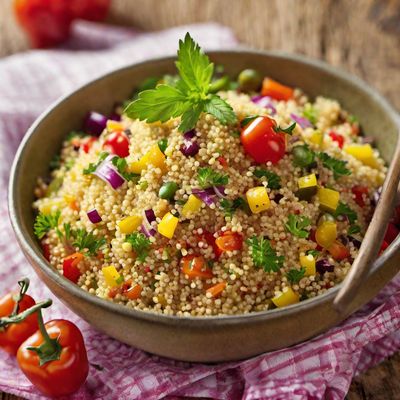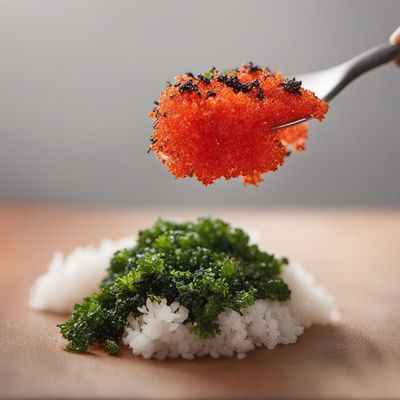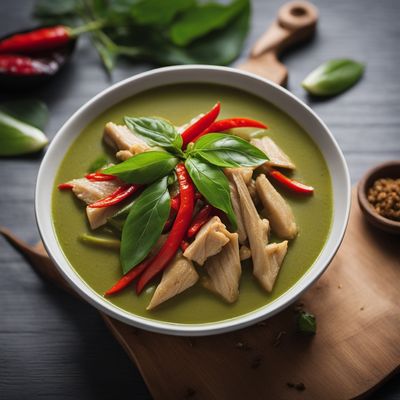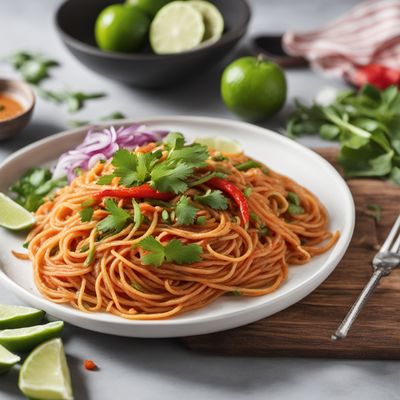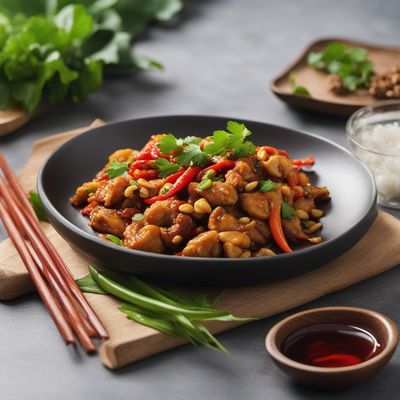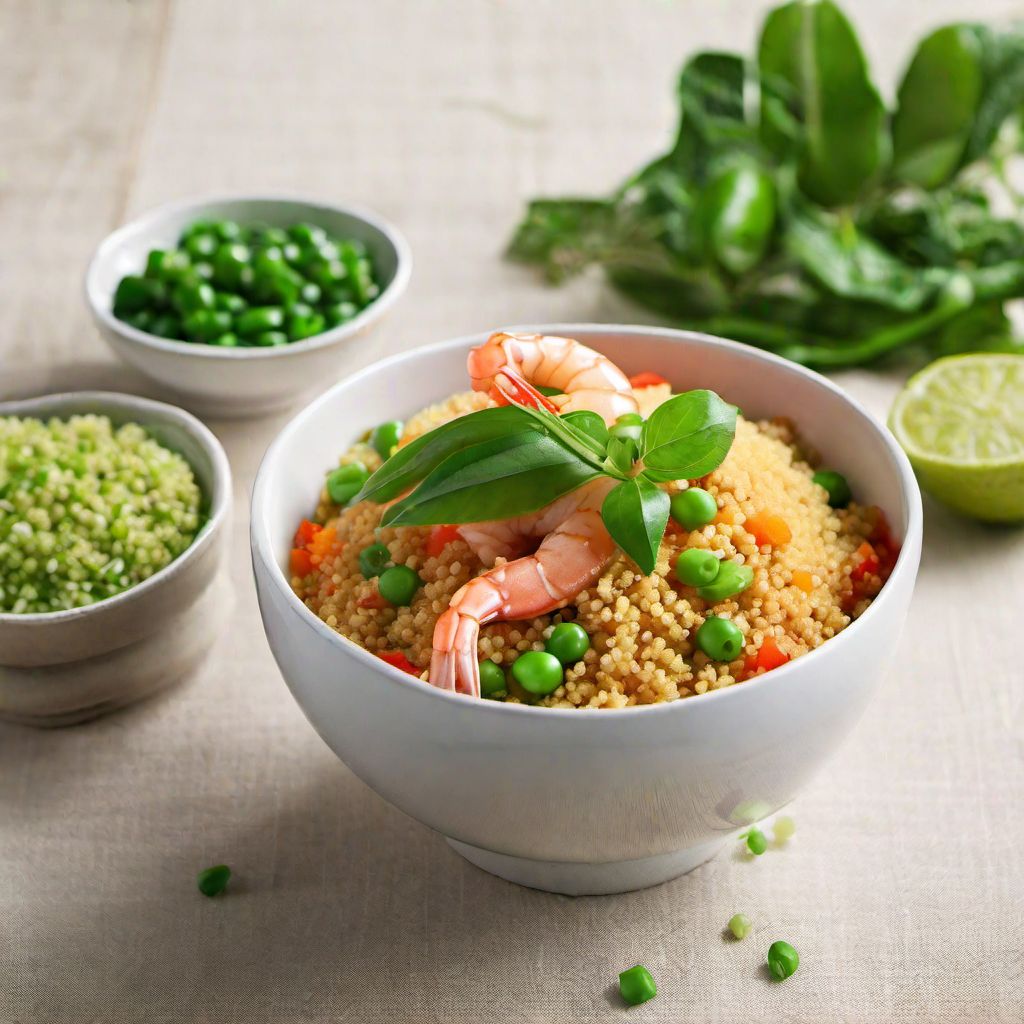
Recipe
Thai-style Couscous
Thai-inspired Couscous Delight
4.9 out of 5
In Thai cuisine, the flavors are vibrant and the dishes are known for their balance of sweet, sour, salty, and spicy elements. This Thai-style Couscous recipe takes the traditional North African dish and infuses it with the aromatic and exotic flavors of Thai cuisine, resulting in a delightful fusion of cultures.
Metadata
Preparation time
15 minutes
Cooking time
10 minutes
Total time
25 minutes
Yields
4 servings
Preparation difficulty
Easy
Suitable for
Vegetarian, Pescatarian, Gluten-free (if using gluten-free soy sauce)
Allergens
Shellfish (shrimp)
Not suitable for
Vegan, Dairy-free
Ingredients
While the original North African couscous is typically seasoned with spices like cumin and coriander, the Thai-style couscous incorporates Thai ingredients such as lemongrass, lime, and Thai basil. The flavors are lighter and fresher, with a hint of spiciness that Thai cuisine is known for. We alse have the original recipe for Couscous (dish), so you can check it out.
-
2 cups (470ml) vegetable broth 2 cups (470ml) vegetable broth
-
1 ½ cups (300g) couscous 1 ½ cups (300g) couscous
-
1 stalk lemongrass, bruised 1 stalk lemongrass, bruised
-
1 lime, zest and juice 1 lime, zest and juice
-
1 tablespoon soy sauce 1 tablespoon soy sauce
-
1 tablespoon fish sauce 1 tablespoon fish sauce
-
1 tablespoon vegetable oil 1 tablespoon vegetable oil
-
1 red bell pepper, diced 1 red bell pepper, diced
-
1 carrot, grated 1 carrot, grated
-
1 cup (150g) frozen peas 1 cup (150g) frozen peas
-
1 cup (150g) cooked shrimp, peeled and deveined 1 cup (150g) cooked shrimp, peeled and deveined
-
1/4 cup (10g) fresh Thai basil leaves, chopped 1/4 cup (10g) fresh Thai basil leaves, chopped
-
Salt and pepper to taste Salt and pepper to taste
Nutrition
- Calories (kcal / KJ): 320 kcal / 1340 KJ
- Fat (total, saturated): 5g, 1g
- Carbohydrates (total, sugars): 58g, 6g
- Protein: 12g
- Fiber: 6g
- Salt: 1.5g
Preparation
-
1.In a saucepan, bring the vegetable broth to a boil. Remove from heat and add the couscous. Cover and let it sit for 5 minutes until the couscous absorbs the liquid.
-
2.Fluff the couscous with a fork to separate the grains.
-
3.In a small bowl, combine the lime zest, lime juice, soy sauce, fish sauce, and vegetable oil. Set aside.
-
4.Heat a large skillet over medium heat. Add the red bell pepper, carrot, and frozen peas. Cook for 3-4 minutes until the vegetables are slightly tender.
-
5.Add the cooked shrimp to the skillet and cook for an additional 2 minutes.
-
6.Stir in the cooked couscous and the lime-soy dressing. Cook for another 2 minutes, stirring continuously.
-
7.Remove the lemongrass stalk from the skillet and discard.
-
8.Season with salt and pepper to taste.
-
9.Remove from heat and garnish with fresh Thai basil leaves.
Treat your ingredients with care...
- Lemongrass — Bruise the lemongrass stalk by lightly pounding it with a rolling pin or the back of a knife to release its flavor.
- Thai basil — Use fresh Thai basil leaves for their distinct aroma and flavor. If unavailable, regular basil can be used as a substitute.
Tips & Tricks
- For a vegetarian version, omit the shrimp and add tofu or tempeh for protein.
- Adjust the spiciness by adding Thai chili peppers or chili flakes.
- Add chopped peanuts or cashews for extra crunch and flavor.
- Serve the Thai-style couscous as a main dish or as a side dish with grilled chicken or fish.
- Leftovers can be refrigerated and enjoyed cold as a refreshing salad the next day.
Serving advice
Serve the Thai-style couscous hot, garnished with additional fresh Thai basil leaves and a wedge of lime for squeezing over the dish.
Presentation advice
For an appealing presentation, mound the Thai-style couscous in the center of a plate and garnish with a sprig of fresh Thai basil. Surround the couscous with colorful slices of bell pepper and carrot for a vibrant and appetizing look.
More recipes...
For Couscous (dish) » Browse all
For North African cuisine » Browse all
For Thai cuisine » Browse all
More North African cuisine dishes

Babor
Rice porridge
Babor is a traditional dish from Algeria that is made from semolina flour. It is a hearty and flavorful dish that is often served for breakfast or...

Couscous (dish)
Couscous
Couscous is a traditional North African dish made from small steamed balls of semolina. It is a staple food in many countries in the region and is...
More Thai cuisine dishes » Browse all

Thot man kung
Thai Fish Cakes
Thot man kung is a popular Thai dish made with shrimp cakes. It is a delicious and flavorful meal that is perfect for any occasion.

Phuket-Style Crab Curry
Phuket-Style Crab Curry is a classic Thai dish made with fresh crab and a spicy curry sauce. The dish is known for its bold flavors and unique texture.

Kaeng pa
Jungle curry
Kaeng pa is a spicy Thai curry that is made with a variety of meats and vegetables. It is known for its complex flavors and use of fresh herbs and spices.

